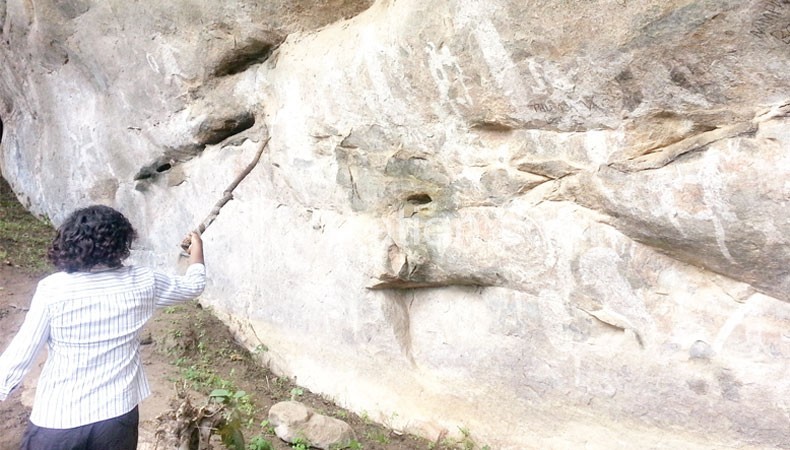Security concerns raise alarm bells at Chongoni

There are concerns that one of Malawi’s national treasures, the Chongoni Rock Art paintings in Dedza, risk being defaced.
During a visit by Minister of Arts, Wildlife and Culture Moses Kunkuyu, who was joined by Norwegian ambassador Asbjorn Eidhammer, it was discovered that Ntchentcherere, one of the places with the rock paintings, was poorly managed in terms of security.
As such, the Ministry of Arts, Wildlife and Culture is planning on constructing a fence at Chongoni, which is a Unesco World Heritage site.
Chongoni Rock Art consists of 127 sites in the forested hills of the Malawi plateau with depictions of rock art and paintings of the farmer community of the late Stone Age and the Iron Age period.
“Initially, there was a security fence but it was vandalised as people around the area thought there were being blocked from accessing something that belongs to them. As government, we have funds which we are using to construct an information centre at Chongoni Rock Art offices and we could use the same funds to upgrade this place by among others, working on the road, to this end, creating steps up the hill as you can see its sloppy meaning during the rainy season it is difficult to get up here,” explained Kunkuyu.
He mentioned that such places need to be protected as they preserve Malawi’s history.
Ambassador Eidhammer hailed the ministry for recognising the importance of protecting such historical sites.
“This is a good initiative that the government of Malawi has taken to protect such places. The country is on its way of becoming important tourist destinations but there’s a lot to do in terms of facilities,” he said.
According to Director of Antiquities Chrissie Chiumia, Chongoni has the richest concentration of Rock Art in the Central African region.
“The site is of international importance because it has large and well-preserved rock paintings sites belonging to two important and rare African Rock Art traditions. The red schematic paintings of various geometric patterns could be some 3 500 years old and are thought to have been made by the hunter-gatherer Akafula who inhabited the area before the Bantu migrations.
“The white paintings are mainly of animals or mythical animal-like figures which represent spirits and are used in traditions like initiations. A unique aspect of the paintings is that high proportions are known to have been made by women. The sites remain important to local culture and rituals and dances are still performed there,” said Chiumia.
According to information sourced from the website www.visitdedza.com, Chongoni is of international importance because it has large and well-preserved rock paintings sites belonging to four important and rare African Rock Art traditions.
The red schematic paintings of various geometric patterns could be some 3500 years old and are thought to have been made by the hunter-gatherer Ba-Twa pygmies who inhabited the area before the Bantu migrations.
The white paintings are mainly of animals or mythical animal-like figures which represent spirits and are used in Nyau dance. These can be quite recent, as a depiction of a car illustrates. A unique aspect of the paintings is that a high proportion are known to have been made by women. The sites remain important to local culture and rituals and dances are still performed there.
Three of the sites are open to the public – Chentcherere, Namzeze and Mphunzi. The Antiquities Section of the Malawi Dept of Culture is trying to maintain them. It is building an information centre in the grounds of the College of Forestry and Wildlife which will be open in 2012. There will also be a workshop for local women’s groups to make and sell crafts.
The Chentcherere and Namzeze Rock Art sites are about 6 kilometres and 12 kilometres north of the Malawi College of Forestry and Wildlife and are off the main dirt road.
They are not marked and visitors will need a local guide to find them. Some businesses in the area provide this service. Ask at the Dedza Pottery or the Kazela Lodge/Ed’s Bar at the College. Reaching the sites also involves an uphill walk on a steep, uneven tack for which appropriate footwear is needed. The Namzeze one is over 500 metres and may not be suitable for people who would struggle with these conditions.
The Forestry College can be approached from the M1 at the turning to the east signposted for the College, which is north of the Dedza Township turning.
Alternatively, exit the M1 at the northern junction for the Dedza Township tarmac road. After 100m turn left onto the dirt road and drive 8km past the Dedza Pottery. This road is sometimes in poor condition because of use by the heavy Wico sawmill lorries. The Mphunzi site is to the west of the M1 off the Lobi dirt road.





